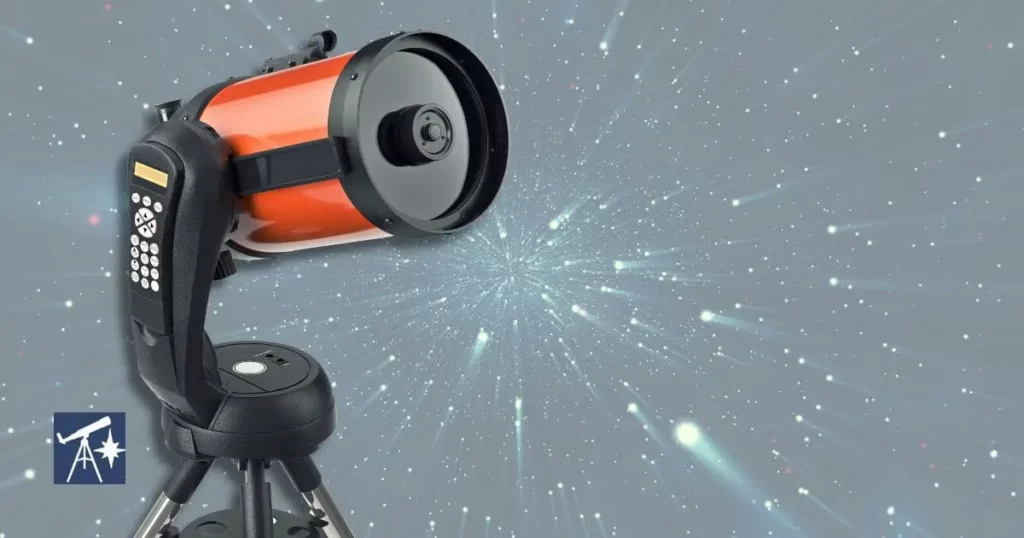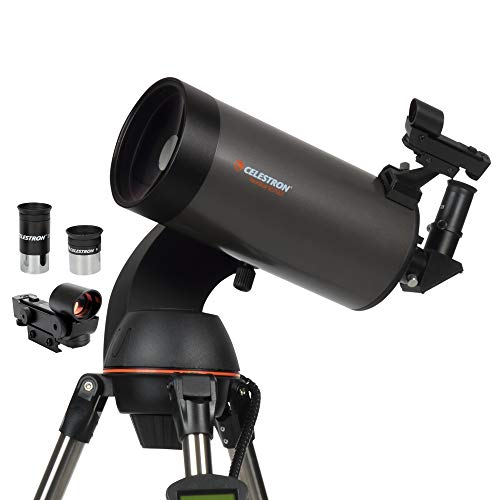I’ve recently discovered the world of catadioptric telescopes. Here, I share insights on why these telescope types are popular in backyard astronomy.

Catadioptric telescopes are a type of telescope that uses a combination of mirrors and lenses to reflect and refract light. The name expresses this combination.
The word “catoptric” refers to the study of reflection and “dioptric” to the study of refraction in optical instruments.
There are a few variations to the design, which include the Maks and the SCTs.
They are popular among amateur astronomers due to their versatility and ease of use.
What’s good about catadioptrics?
As an astronomy enthusiast, I’m always on the lookout for new or better ways to explore the mysteries of the universe. Why is a catadioptric any better than a reflector or refractor telescope?
One big advantage of catadioptric telescopes over other types is their compactness. They are more compact than refracting telescopes of the same aperture size. Plus, their folded optical path allows for a longer focal length in a shorter tube, which can mean better image quality.
Five key benefits of catadioptric telescopes:
- Compact design
A compact design in an astronomy telescope is advantageous for backyard astronomers because it makes the telescope more portable and easier to set up and store. This means that the telescope can be easily moved to different locations for optimal viewing and can be stored in a smaller space when not in use. Additionally, a compact design often means that the telescope is lighter in weight, which makes it easier to handle and manipulate. - Wide field of view
A wide field of view in an astronomy telescope allows backyard astronomers to see a larger portion of the sky at once, making it easier to locate and observe celestial objects. This is especially useful for finding faint or elusive objects, such as comets, or deep-sky objects like galaxies and nebulae. Additionally, a wider field of view allows for better context and appreciation of the surrounding stars and constellations. - Good for astrophotography
They are well-suited for astrophotography due to their fast focal ratios and ability to correct for optical aberrations.
An astronomy telescope that is good for astrophotography allows backyard astronomers to capture stunning images of celestial objects such as stars, galaxies, and planets. This is beneficial because it allows them to study and share their observations with others, and it also provides a way to document changes over time. Additionally, astrophotography can be a rewarding and enjoyable hobby that enhances the overall experience of stargazing. - Multi-functional
They combine refractive and reflective elements, making them versatile for both visual observation and astrophotography
Instead of having multiple telescopes for different purposes, a multifunctional telescope can save space and money. It also provides versatility and flexibility in observing different objects, such as planets, stars, galaxies, and even comets. - Low maintenance
They require minimal maintenance compared to some and are typically more durable than other types of telescopes because of their compactness.
Because of their compact design, the catadioptric telescopes are more portable than the typical reflector. I wrote how reflectors need collimation. Catadioptrics need it far less frequently. They can stay aligned and may only need collimation every few years.
Care of catadioptric
Much like any other telescope, maintaining a catadioptric typically involves cleaning the optics, careful handling to avoid damage to fragile parts, and periodic alignment to ensure optimal performance.
It is also important to store the telescope in a dry and secure location when not in use to prevent damage from moisture or dust. Additionally, collimation, or alignment of the optical elements, may be necessary from time to time to maintain the telescope’s accuracy.
The catadioptrics are versatile, being great for deep sky use as well as a home telescope for viewing planets and the moon.
Catadioptric telescopes can be equipped with goto systems, but not all of them have this feature.
Catadioptric telescope types
There are three main types of catadioptric telescopes:
- Maksutov-Cassegrain (Maks)
- Schmidt-Cassegrain (SCT)
- Ritchey-Chretien
You’ll notice the Cassegrain in the naming of two of the first two. The Cassegrain is a reflector telescope. Reflectors use mirrors. In the case of the Cassegrain, a combination of concave and convex mirrors is used. Such a design has been around since the 17th century.
1. catadioptric design: Maksutov-Cassegrain telescope

A Maksutov-Cassegrain
Available at Amazon (affiliate link)
The Maksutov-Cassegrain telescope (Mak) came into use in 1944 (during World War Two). It offered a compact design and used a thick meniscus-shaped lens, usually spherical or slightly elliptical.
The name comes from Russian astronomer Dmitri Maksutov (1896-1964), who added the thick style of corrector lens to the Cassegrain reflector.
The design corrects for spherical aberration and coma, which are both common optical aberrations in telescopes.
This type of telescope is great for planetary observing because it provides a high level of contrast and sharpness.
2. Catadioptric Model: Schmidt-Cassegrain telescope
The Schmidt-Cassegrain telescope (SCT), in contrast to the Mak, uses a thin aspherical correcting plate instead of the thick meniscus lens.
German optician Bernhard Schmidt developed the design, adding the thin corrector plate to the Cassegrain reflector design in the 1930s.

A Schmidt-Cassegrain
See what buyers say about it at Amazon (affiliate link)
The SCT design offers a wider field of view than the Maksutov-Cassegrain telescope, making it ideal for deep-sky observing.
3. Catadioptric make: Ritchey-Chretien telescope

A Ritchey-Chretien
See the price at Amazon (affiliate link)
The Ritchey-Chretien telescope is a more complex design that uses hyperbolic mirrors to correct for optical aberrations. The American astronomer George Willis Ritchey and French astronomer Henri Chrétien invented the design before WW1, in the early part of the 20th century.
This design is favored by professional astronomers for its ability to produce a large flat field of view with minimal distortion.
I wrote about how it compares with the Schmidt-Cassegrain (SCT) in my article comparing the Orion and Celestron Cassegrain Telescopes.
How catadioptrics compare in price
One downside of catadioptric telescopes is their higher cost compared to other types of telescopes for viewing planets and the like.
The three main catadioptric telescope types, Schmidt-Cassegrain, Maksutov-Cassegrain, and Ritchey-Chrétien, can vary in price range depending on the brand, size, and features.
Generally, Schmidt-Cassegrains are the most affordable, with prices ranging from a few hundred to a few thousand dollars.
Maksutov-Cassegrains and Ritchey-Chrétien telescopes tend to be more expensive, with prices ranging from a few thousand to tens of thousands of dollars.
However, prices can vary widely and it’s important to research specific models and brands for accurate pricing information.
Tips on choosing your catadioptric
The type of telescope you choose depends on your intended use. Here are some points to consider:
- If you’re interested in observing planets, the Maksutov-Cassegrain telescope is a great choice due to its high contrast and sharpness.
- If you’re interested in deep-sky observing, the Schmidt-Cassegrain telescope is a better option due to its wider field of view.
- The Ritchey-Chretien telescope, while more complex and expensive, is a good choice for professional astronomers or astrophotographers who require a large flat field of view with minimal distortion.
FAQs
What are the advantages of using a catadioptric telescope?
Catadioptric telescopes have several advantages, including their compact size, their ability to provide a wide field of view, and their ability to provide high-quality images with minimal aberrations.
What are the different types of catadioptric telescopes?
There are three main types of catadioptric telescopes: Schmidt-Cassegrain telescopes, Maksutov-Cassegrain telescopes, and Ritchey-Chretien telescopes. Each type has its unique design and features.
